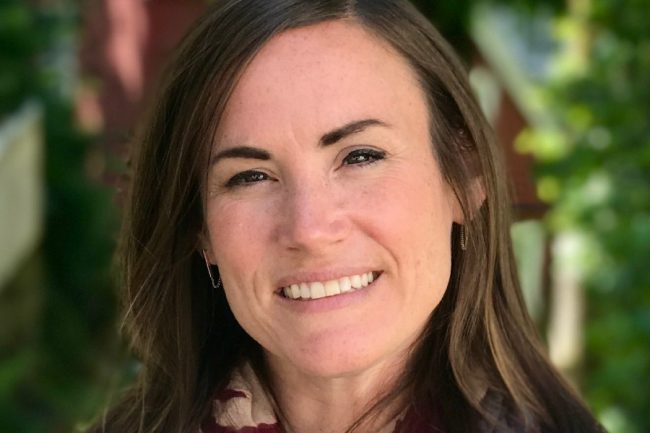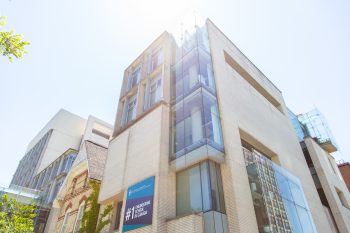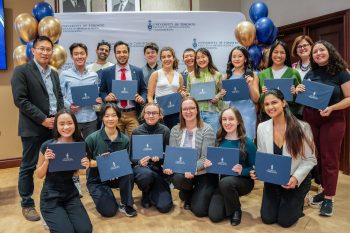Professor Lydia Wilkinson recently joined the Institute for Studies in Transdisciplinary Engineering Education & Practice (ISTEP) as a faculty member. Wilkinson has been an instructor at U of T Engineering since 2007, helping to develop undergraduate and graduate courses in the Department of Chemical Engineering & Applied Chemistry (ChemE) and the Engineering Communication Program (ECP) on themes including communication and engineering research methods.
Her teaching at U of T Engineering is informed by her background in education and the humanities. “The former provides me with a solid foundation in pedagogical theory and approaches to curricular development, while the latter equips me to be creative while innovating in these spaces,” says Wilkinson.
Writer Liz Do spoke with Wilkinson to learn more about her teaching philosophy and what she hopes to accomplish as an educator at ISTEP.
Why did you choose to join ISTEP at U of T Engineering?
As a longtime sessional instructor within ECP I was highly invested in the creation of ISTEP in 2018. My teaching within the Faculty has always been focused on transdisciplinary competencies — skills like communication, teamwork, ethics and equity and sustainability transcend a single engineering discipline and better prepare our students from across the Faculty to be effective, impactful and ethical engineers.
I’m passionate about curricular development and pedagogical innovation, and I see ISTEP as a leader not only in Canada but across North America in working to redefine the way that we integrate these types of competencies in meaningful ways across the curriculum.
How would you describe your teaching philosophy?
There are five pillars to my teaching philosophy: 1) Learning is most impactful when students understand why they are learning what they are learning; 2) a classroom is a community; 3) students learn in different ways; 4) learning is iterative; and 5) teachers are also learners.
In practice, I work to foster an environment that is supportive, and work to engage students in multiple ways. I design curriculum so that learning is scaffolded and so that students can develop skills initially without the pressure of failure. I am highly transparent in my teaching and engage students in choices around curricular design and delivery.
What do you hope to accomplish as an educator this term?
I am starting this position and returning to my teaching responsibilities this term from a maternity leave that conveniently coincided with the start of the pandemic, meaning that I haven’t spent the last nine months adapting to teaching in an online environment.
My classrooms tend to be highly interactive and participatory, so I’m working to develop creative ways to maintain this engagement within the constraints of our new reality. I’ll be looking to my students and colleagues who have spent the last two terms navigating these new teaching and learning environments.
What are your long-term plans or goals as an ISTEP faculty member?
I’m excited to contribute to course development, identifying opportunities for transdisciplinary integration within the existing core curriculum, but also designing courses that can provide students with instruction in multiple transdisciplinary skills through new learning experiences.
CHE399: Engineering Consultancy is a great example of this approach, as it brings together multiple competencies in a novel learning environment: a simulated professional consulting bidding process. There is also a need to support the development of these transdisciplinary strengths within our graduate students, and I plan to continue the work I’ve started in CHE1102: Research Methods and Project Execution, as well as identifying other opportunities for ISTEP’s involvement.
As a busy sessional instructor, balancing teaching with my interests as a researcher was a real challenge. Now that I’m an ISTEP faculty member I’m also excited to continue to develop research projects in a program where this is actively encouraged.
What are three things U of T Engineering students should know about you?
First, I may not be an engineer, but I do have a patent with the United States Patent Office. Years ago, a Praxis activity got me thinking about creative ways to help our students beat the winter blues, which led me to come up with ‘Method and apparatus for growing life forms under remote influence.’ My invention hasn’t made me a fortune yet, but I’m keeping my fingers crossed.
Second — your classroom is my lab. My engineering education research focuses on the intersection of engineering and the humanities. In my thesis, I study this within our Humanities electives here within the Faculty, but more broadly, I’m interested in the way that engineering students engage with concepts and practices that we might often associate with a liberal or holistic education, like critical thinking, communication and teamwork, ethics and equity, and the impact of engineering on society. Your classrooms give me a space to observe this engagement, and ISTEP provides a home in which this holistic engineering framework is central to its mandate.
I also want to hear about my peers’ research. Although my career goals have always been focused on education, finding my home in engineering initially came as a surprise. Two things got me hooked: the challenge of developing strategies within a new teaching environment, and the opportunity to learn about the exciting innovations taking place in scientific fields and to speak with the students and faculty who lead this research. Hearing about the advances taking place in our labs keeps me hopeful for our future.
Lastly, I’m approachable!



